 Paulista War Armored Trains
Paulista War Armored Trains
Introduction: Context of the Paulista War (July-November 1932)
Better known officially as the "Constitutionalist Revolution", this Brazilian civil war is certainly less well known that the Spanish civil war of 1936-39, bit it was as bitter and hard-fought, with as much modern technology as was the latter, but concentrated on five months.The Constitutionalist Revolution was a popular uprising in the São Paulo state, against the Brazilian Revolution of 1930. When Getúlio Vargas assumed presidency, he was supported not only by populations but also the military and political elites of the major states of Minas Gerais, Rio Grande do Sul and Paraíba.
However pas the first year and a half of "popular grace" resentment grew from the autocratic tendencies of Vargas ruling by decree and so over the head of the parliament for his reforms as well as in contradiction to the Constitution, and doing so past his time in a provisional government.
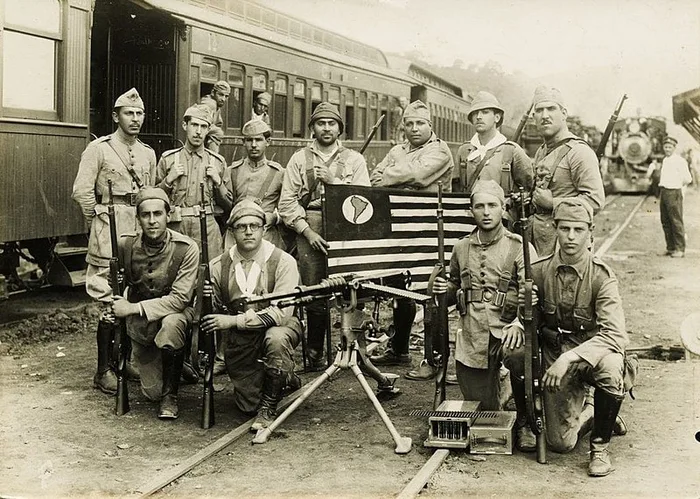
Soldiers of the armored train number 4 during the constitutionalist revolution of 1932
Discontent eventually cristallized in the 1930 Revolution which affected São Paulo as Vargas consistently eroded its autonomy as a states, according to the 1891 Constitution. He went as far as preveting the election of governor Júlio Prestes, carried by popular support, and former president of Brazil in 1930, succeeding to President Washington Luís (1920-1924) and 1930 saw the end of the First Brazilian Republic.
The Revolutionries from Sao Paulo wanted to constrain the provisional government of Getúlio Vargas to adopt a new Constitution and enable Júlio Prestes to succeed him at the office. Resentment against Vargas only grew after news of the refusal, and the movement started to rally more and more support, not only in the state but in the others as well, with the same goal of overthrowing the Federal Government, and potentially (for the most extreme branch of the "Paulistas"), complete secession of São Paulo from the federation. Thus, these revolutionaries were soon called "separatists" and also "rebels".
Since Vargas had support from the army, the Paulistas started to use guerrilla tactic against the Federal Government, while the latter wanted to turn the population and Brazil at large against the state of São Paulo. It seems however Paulistas commanders remained defiant from this separatist claims and stuck to the original goal, ensuring a broader support.
Overview of the war
The uprising started as most historians agrees, on July 9, 1932. Four protesting students were killed by government troops on May 23, 1932 and a movement called MMDC (after the students killed, Martins, Miragaia, Dráusio and Camargo) started and grew in June. In July, the movement organized itself as a military force, armed and trained to start a guerilla campaign.Their movement made a broadcast announcement for the entire state of São Paulo of open rebellion that day. They also later gained support of political elites in Minas Gerais and Rio Grande do Sul, to back the army financially, which was essential to win a war aainst federal army. Politicians from São Paulo wanted a quick war ad soon provided plenty of ammunitions and rifles, purchsed abroad when those seized locally were not sufficient. Let's have a quick look ay the opposing forces:
Paulistas Forces
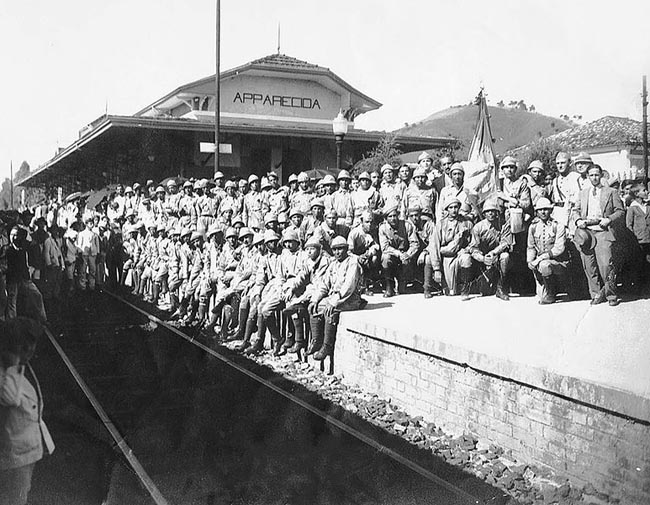
São Paulo volunteers at the Aparecida-SP railway station waiting to board for the 'front' of combat in the Revolution of 1932.
According to García de Gabiola, on 8 divisions of the Federal Brazilian Army, the Paulistas ony managed to gain support of the single 2nd Division based in São Paulo and half of a Mixed Brigade in Mato Grosso. Soon this was bolstered by the Força Pública Paulista, the local state military police and the MMDC militias. In total, they started in July with some 11,000–15,000 men but soon grew to accept thousands of volunteers. Hilton stated that in August the state was abme to muster 40 battalions of volunteers, all armed. García de Gabiola saw the double, 300 men strong each. Training and command was an issue from the start.
The São Paulo state armory contained between 15,000 and 29,000 depending on soures, so Paulistas were never able to muster more than 35,000 armed men at the most. As for foreign purchases of rifles, they needed intermediaries and proved complex as they were officially "rebels" for the international community. Smuggling arms became a priority. The Paulistas were even more limited in ammunition with just 6 million cartridges while projection showed they needed at least 500 million for 3 months, or 4.4 cartridges a day per soldier. Between the state division, the military police, the volunteers and the MMDC militias, the Maracaju volunteers and Rio Grande do Sul Gaúcho United Front jpined in, but at the most, the Constitutionalsts could only muster circa 40,000 men in arms at any moment during these few months.
Naturally, they would muster the local railway support, hundreds of trucks, factories, and a few aircraft for reconnaissance, as well and the workshops necessary to produce "tanks" in support. In total, the Paulistas would have for their use in this war some 30 Armored Vehicles, all improvized conversions, 44 artillery pieces and 9 to 10 aircraft, all volunteers.
Loyalist Federal Forces
Brazil at the same time still had seven infantry divisions at its disposal or 100,000 men, but 1/3 never went to the front and just secured the rearguards or for security purposes, but it still made for a 2 to 1 advantage. The army was under command of Góis Monteiro, Valdomiro Lima, Augusto Cardoso and Eduardo Gomes, and possessed the bulk of the available ground, air and naval forces. During the conflict, they deployed 90 Armored Vehicles (including the Army's French-built Renault FTs and the remainder as conversed vehicles), as well as organic artillery for these divisions, some 250 artillery pieces, mostly howitzers, and the air force in totality, some 58 aircraft, fighters and bombers, a naval air force and four Warships on the totality of the Brazilan navyn used for the Naval blockade of the Port of Santos, preventing the "rebels" to get any arms shipment from abroad.The Operations:
To make for their weakness in men, training and equipments, the Paulistas expected to fight a guerilla war, which proved efficient time and again in history. Their leaders, amnong which were Pedro de Toledo, Isidoro Dias Lopes, Bertoldo Klinger, Vespasiano Martins (for Mato Grosso do Sul state), Euclides Figueiredo, Júlio de Mesquita, Marcondes Salgado, Borges de Medeiros (for Rio Grande do Sul) or Artur Bernardes were divided however about the way to fight. Some specified that given their wish of changing the constitution, the only honorable way was to win over Federalists in a pitch battle, to be internationally reported in the press and give the movement some legitimacy.The first front was the eastern Paraíba Valley leading to Rio de Janeiro, where the two armies were likely to meet. The 2nd Division which revolted advanced indeed against Rio de Janeiro but was awaited by the Brazilian "loyalist" 1st Division ( General Góis Monteiro) just on the border between both states. Well dug-in with strong defensive positions, guns mortars and MG emplacements, CiC General Tasso Fragoso at first however trie dto oppose the troops deploying in the valley, fearing Paulistas ambushes. But he apparently wanted to retain his troops for a possible similar uprizing in Rio de Janeiro. Monteiro overruled Fragoso and thus the 1st Division (the elite of the Brazilian Armt), was placed right in time to block the Paulista advance. It was a bloodbath. Having no heavy equipments, the Paulistas led charges which ended the same way. They also tried to go around on the Valley, but hit prepared strongpoints al the same.
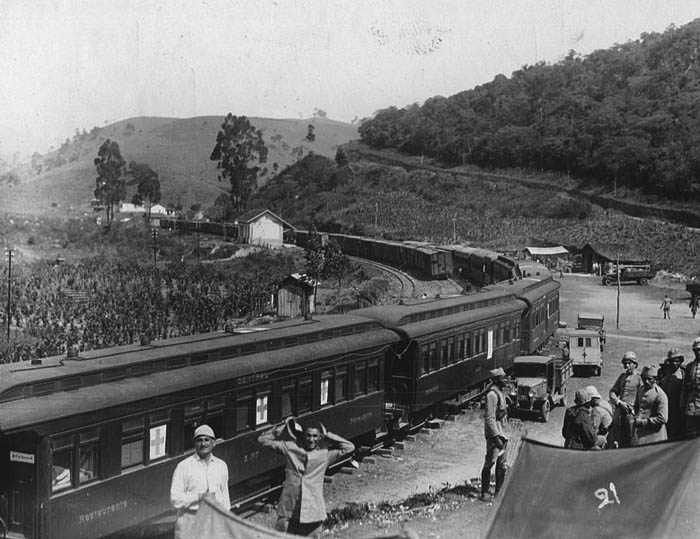
Hospital train of the Public Force of Minas - Manacá (cc)
In the Paraíba, Góis Monteiro created the East Detachment (34,000 men) to face 20,000 Paulistas. The conflict soon degenerated into 3 months of trench warfare. The Paulistas failed to advance more than 70 km, some 150 km from the capital São Paulo when a ceasefire was decided.
In the south of the state, the South Detachment was created with the federal 3rd and 5th divisions screened by 3 cavalry divisions, and the "gaucho brigade" of Rio Grande do Sul. They reached 18,000 men but faces only 3 to 5,000 Paulistas. The federalists managed to breakthrough rebels on their own defensive line in Itararé. It was done on July 17, and led to the largest advance of the Federalists in this war, however they failed to reach São Paulo (far from it) when the war ended.
The decisive front proved to be in Minas Gerais from August 2, in which the 4th Federal Division from this state, rallying the Police of Minas Gerais and other local troops alsl assaulted Paulista's line in Eleutério, a district of Itapira. The breakthrough was done on August 26 and they advanced to 50 km of Campinas, bringing some 18,000 soldiers against 7,000 Paulistas. The 4th Division stopped at 70 km from São Paulo. The Paulistas eventually surrendered in October 2 to General Valdomiro Lima, the uncle of Vargas' wife.
Defeat of the Constitutionalists
Which such discrepancy of forces and an expected support that did not materialize, São Paulo's revolt was militarily crushed on October 2, 1932. The 87 days of fighting between July 9 to October 4, 1932 ended with the surrender of São Paulo, 934 official deaths, unofficial 2,200 dead and damage across the capital and neighbouring cities during the fighting. In spite of the defeat, the revolutionary were finally granted by Vargas the appointment of a non-military state Governor, election of a Constituent Assembly and a new Constitution in 1934, which was however short-lived. By 1937 growing extremism on bot the right and left conducted Vargas to close the National Congress and re-established the former (modified) Constitution establishing the "Estado Novo" in a coup d'état..
Armored Trains and trains use in the war
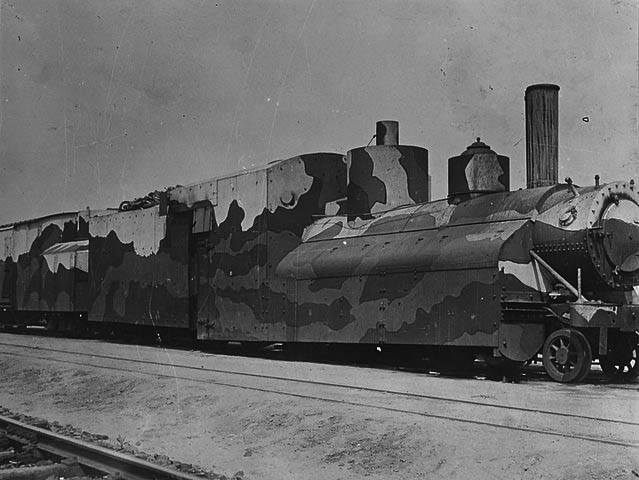
Trem Blindado TB-4, Cie Mogiana (cc)
During this was, trained were used extensively, as rail lines criss-cross both the major coastal states of Rio and Sao Paulo, and communicated in part through Minas Gerais, down the valleys. They proved instrumental, once seized and controlled to bring up troops and supplies. There were a few armored trains however (see later). The Brazilian Army Heavy weaponry were procured over the years from German and French companies, Krupp and and Schneider. The former provided 75mm L/28 cannons and the troops deployed around 36 pack artillery and 108 field pieces, with perhaps 232 of the L/28 type and from 1907, 24 Krup L/14 mountain guns, in 1908 30 105 mm howitzers replacing the antiquated M1892 53mm cannons, Maxim Nordenfeldt M1889s and Canet M1890 howitzers (75mm and and 100mmp. Further orders in 1913 were prevented by WWI. Schneider came back and sold some 100 M1918 75mm howitzers after the war, and St Chamond 12 M1920 75mm howitzers in 1919. Both the Federals and rebels also had access to massed of WWI surplus Stokes Mortars and coastal artillery The marine Schneider Canet 150mm for example was famously mounted on a carriage and a full crew was dedicated to it. Thus, trains liked these were used for support.
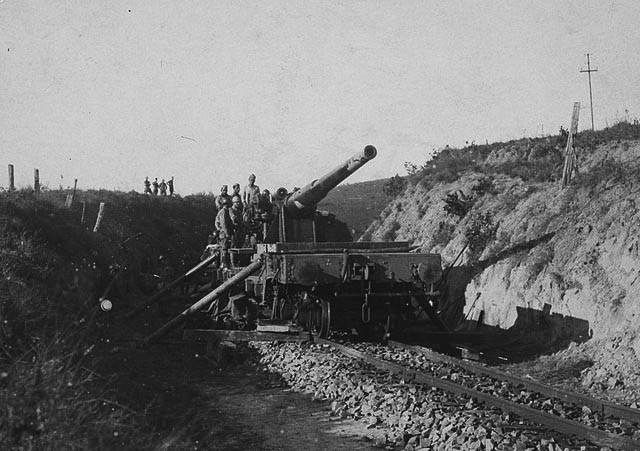
Schneider-Canet gun of Fort Itapu (cc)
Order for the troops and trains was to not advance beyond the Sierra de Mantiqueira at first and the front became static. Only trains and armored cars were still on the move. This story is now preserved Museu Ferroviário Paulista and Sorocabana - Railway Preservation Movement.
"Two kilometers and the enemy in sight. The men advanced, certain it was a goods train, or provisions (really, as it was disguised), and, in a position to fire, knelt by the rails. Our machine guns pecked the unconscious . The first impression was painful. Pungent indeed. Witnessing scenes like this" (Fernando Machado, 1933).
With its more than 7,000 kilometers of railroads, São Paulo had its entire transport system based on railroads. Reaching almost every city in the state, they carried passengers and loads of all kinds; essential for the Paulistas, were of vital and strategic importance. With the outbreak of the Paulista War, in July 1932, it could not be different: from the first week of the conflict, they began to be used to transport troops and supplies to the battle lines.
On the Southern Front, which fought on the border with Paraná, the Paulistas faced difficulties from an early age. Soon, the city of Itararé had been invaded, destroyed and taken over by federal troops, who were heading towards Itapetininga to go to the capital from there and try to depose the state government and military leaders. But the Paulistas were not willing to hand over their land and their fight so easily, and soon, armed resistance began to hinder the advance of enemy troops through the territory of São Paulo. From Itararé, the constitutionalists retreated to Ibiti, then to the region of Engenheiro Maia station and finally to Buri, where they set foot.
But, reaching strategic positions in almost all regions of São Paulo, there was also a military potential to be explored in the railroads. The Southern Front suffered from the lack of better weapons to fight the Brazilian soldiers, since all the heavy weapons of the Public Force of São Paulo had been confiscated when Getúlio Vargas carried out the coup d'état, in 1930, already foreseeing a possible reaction from São Paulo. Then, at the end of July, the idea of creating a real railway machine of war: an armored train. And so it was, in a partnership between the Polytechnic School (today, USP), IPT (Institute of Technological Research) and E. F. Sorocabana, that the TB-1, or Armored Train nº 1, was born. Its conception came from the French engineer Clèment de Baujaneau , who lived in São Paulo and got to know the European armored trains used in the First World War, and their construction by volunteer engineer Augusto Ferreira Velloso, who left his office to help the Polytechnic in the construction of armored vehicles for the War.
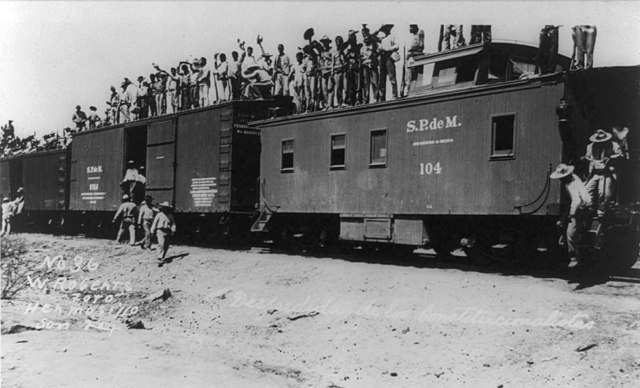
Built in the Sorocaba railway workshop, the TB-1 was composed of a steam locomotive and a wagon, both armored; Inside the wagon, soldiers were located who, through small openings, positioned their 7 mm Hotchkiss machine guns. Above, on the roof, two powerful headlights powered by the locomotive itself fully illuminated the enemy trenches. The report with which we started the text is precisely about one of the first times - if not the first - in which the TB-1 was used in Buri, always causing panic among the ill-prepared Brazilian troops, who had never seen such a powerful weapon of destruction. as that. Commanded by First Lieutenant Affonso Negrão, near the stations of Aracassu, Buri, Eng. Hermillo, Rondinha and Victorino Camillo, and still without being completely finished, managed to completely annihilate the enemy forces in Rondinha and retake the city of Buri in São Paulo, on July 26, 1932.
It was so successful that the second unit was soon built, using locomotive nº 216, named TB-2, and the TB-1 returned to the workshop to be further equipped and transformed into the TB-3. Now, armored trains took on the final basic characteristics, with not one more, but two armored cars (one in front and one behind the locomotive), filled with Hotchkiss machine guns, and now also gaining two 75 mm Krupp or Schneider cannons at the ends. , with immense firepower and ability to defend itself, since the armor was extremely resistant, made of a "sandwich" of pieces of faveiro wood, extremely hard, surrounded by steel plates; where it was not possible to install wood, it was covered with thick gauge steel sheets. There were no doors or windows: external viewing was done through 3 small openings, which also served for air intake, and communication with the drivers was done through a telephone, for orders to "stop", "go forward" or "go back"; entry was made through a small hole in the floor of the wagons. A device similar to a wedge fixed the vehicle to the ground, so that it would not move during shots.
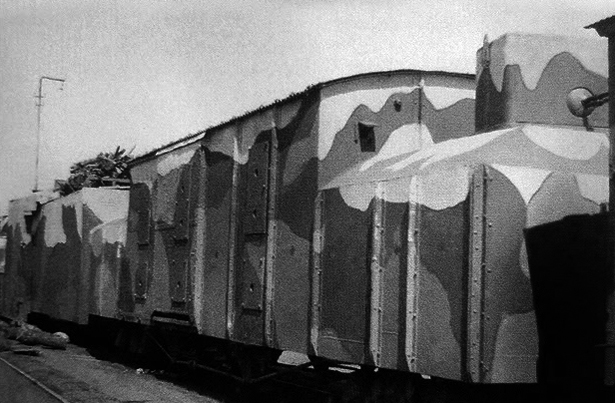
TB-5 (cc)
With a crew of just 18 people, 3 of whom are responsible for operating the train and 15 for handling of weapons. It wasn't easy being part of the TBs team, as the heat inside them was immense, with all the fighters working only in pants. Machine gun operators also struggled due to the small space, many of them getting scars on their arms from ammunition shells bouncing off of them. Common weapons did not cause any damage to the trains, which could only be damaged with more powerful grenades and bombs, which the Brazilians never managed to do. Thus, TB-2 and now TB-3 operated on the Southern Front, in the region of Buri, mainly in places close to the Engenheiro Hermillo, Lidiana and Aracassú stations, where from the railway line it was possible to freely see the hills where the opposing army was. positioned, preventing its advance into the territory of São Paulo.
The immense success of the first two units motivated Politécnica and IPT to team up with engineers from Cia. Mogiana de E. F. e Cia. Paulista de E. F., formerly great rivals for the cargo dispute in the region of Ribeirão Preto, but which left any disagreement aside to fight for the Paulista Cause. The TB-4 was then built by "Paulista" in the Rio Claro workshop, and the TB-5 by "Mogiana" in the Campinas workshop, both to serve the combats on the border with Minas Gerais on the lines of the latter company. Both had some improvements over the first two, being even more technologically advanced. The locomotives used, nºs 730 and 732, were slightly smaller than the previous ones, which allowed for better handling; the wagons gained lowered ends, where the cannons, now installed in rotating turrets, were installed, allowing the trains to attack from all sides at the same time, maintaining the same previous standard crew of 18 people. They also received camouflage paint, with two shades of dark green to blend in with the forest and one of light blue to allude to the sky, helping to disguise it while it was not being used.
Completed at the beginning of August, both were sent to lines close to the border with Minas Gerais, where many of the battles of the war took place. The TB-5 was based in Mogi Mirim, strategically making night raids to Itapira and Eleutério, places where enemy forces were positioned. Both units helped completely block the entry of troops into São Paulo territory in that region, having only entered a little further up, in the Mococa region.
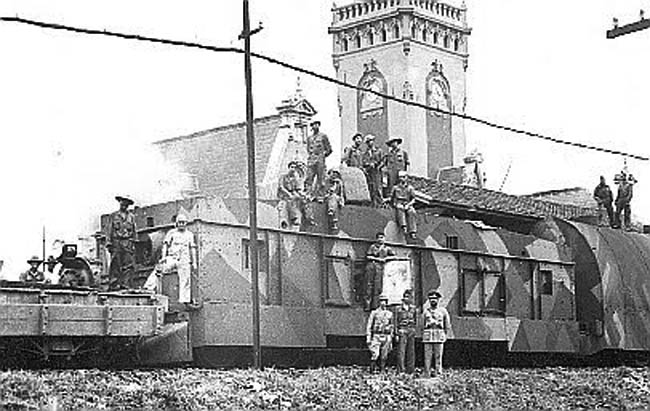
Finally, the last unit appears, named TB-6: the largest and most powerful of all armored trains, also the only one capable of operating on broad gauge lines, built by the railway workshop in the Brás neighborhood, in São Paulo. Paulo capital, for use by E. F. Central do Brasil. Returning to work on the São Paulo branch, the railway line that connects the capital to Rio de Janeiro, cutting across the entire Paraíba Valley, he participated in combats in places such as Cruzeiro, Queluz, Resende and Itatiaia, where he earned the nickname by which everyone became known. : "The Phantom of Death". Sneaky, the unit arrived silently in the dead of night, in the midst of combat, and with its powerful spotlights illuminated the entire battlefield, denouncing where the enemy troops were housed; the latter, seized with terror, ran away in total disarray, leaving behind their positions and armaments, while being shot at by the Paulistas. This one, unlike the others, was composed not of two, but of three wagons, also completely armored and with a reinforced structure, and incorporating in them all the improvements previously developed in the other TBs. He achieved his goal on the Northern Front, which never surrendered and never let the Brazilians invade São Paulo through the south of Minas Gerais and Rio de Janeiro.
After the Paulista War ended, in mid-October, one of the conditions imposed by the federal government was that all heavy weaponry belonging to the Paulistas was confiscated or dismantled. All armored trains were collected from their workshops, where they were later dismantled, and the locomotives used returned to their original conditions, returning to conventional traffic. As a memory of the most powerful weapons of war used in a conflict within the territory of São Paulo. Today, at the top of Buri station, the two searchlights of the former TB-3, all that remained of the Phantoms of Death, in memory of one of the most famous points of São Paulo military engineering, and of all those who participated in the combats. An article by By Thales Vei. More: facebook.com/OrgulhoSP facebook.com/mpefsorocabana/ ugustovelloso.com

"TB-6", an armored train built by rebels of Sao Paulo, Brazil, during the Constitutionalist Revolution of 1932
Illustrations

Canet Train

The Canet Gun open carriage. It fired in support of the Federals stuck in this trench warfare.
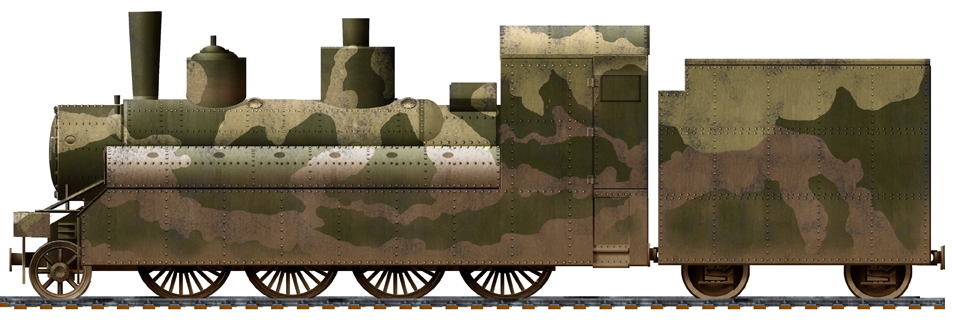
The armoured train ‘Fantasma da Morte’ was the most famous armored train of the conflict, in action in the Mogiana region. It was camouflaged while the locomotive received full-on armor around the cabin. This Paulista Number 6 Armoured Train, ("Death Phantom") towed wagins equipped with machine guns and a Krupp 75mm cannon, and a motorised truck also equipped with machine guns. It helped contain the Varguistas while retreating. While breaking out, it ran over pro-government civilians who tried to derail it.

One of the armoured wagons of the ‘Fantasma da Morte’. Plates were fixed directly on the original frames.

TB4 armoured train, locomotive.
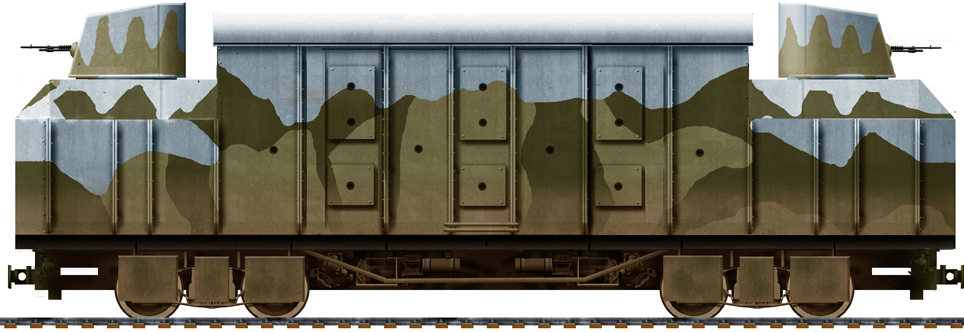
TB4 armoured train

TB6 armoured railway car showing its single turret machine guns on the second wagon and Schhneider gun on the first, behind a sloped plate armour. Last of the train, it needed to be placed on a railway turn to get some initial traverse the remainder being applied to the mount itself.
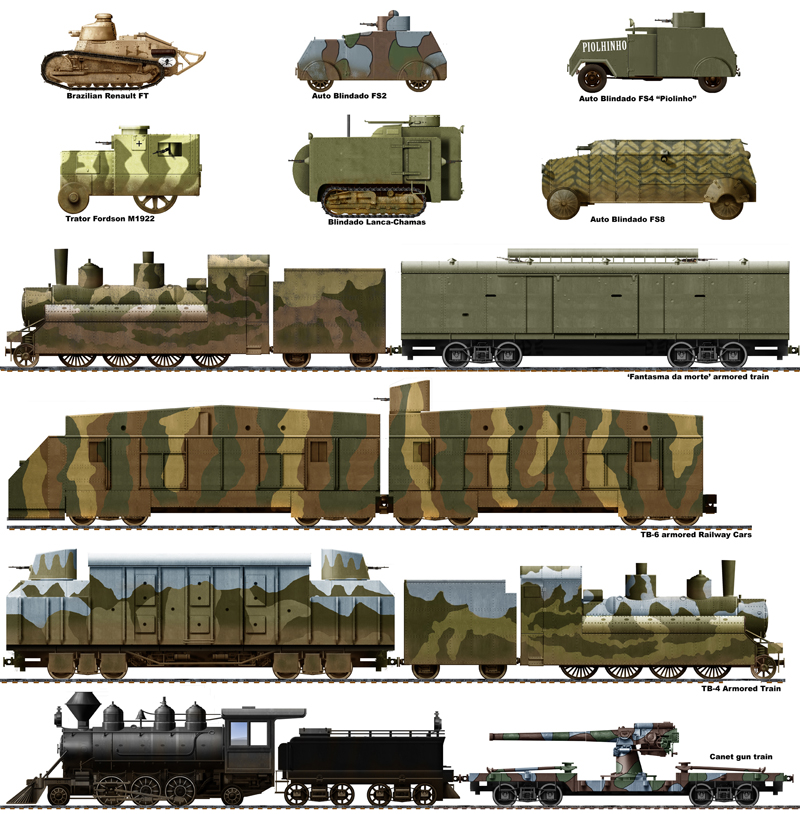
More Photos
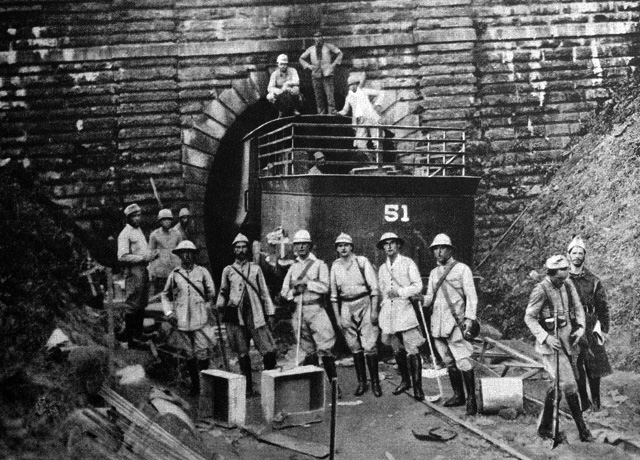
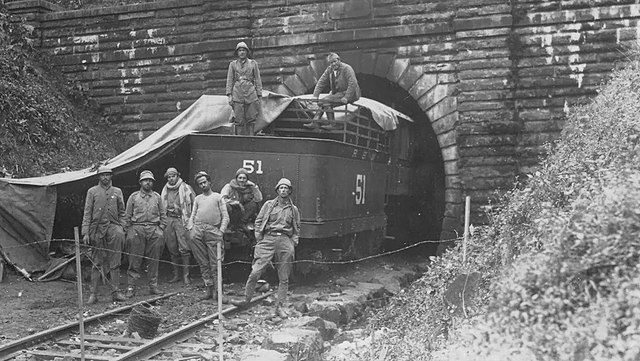
Paulista irregulars and their train at the Tunel de Mantiqueira. Trains did not fared further (cc).
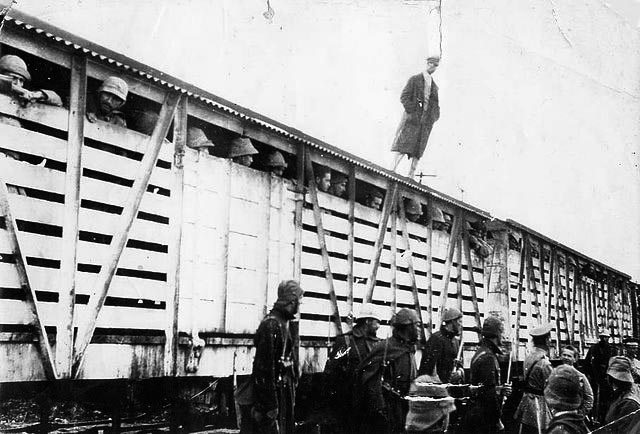
War Prisoners coming from a wagon (cc)
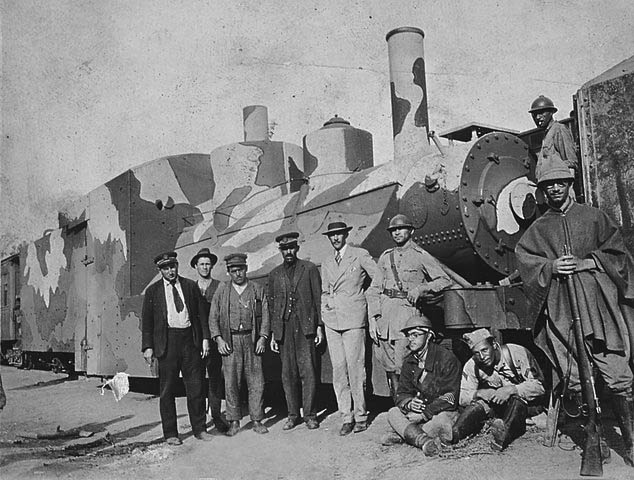
TB-4 Itapira (cc)
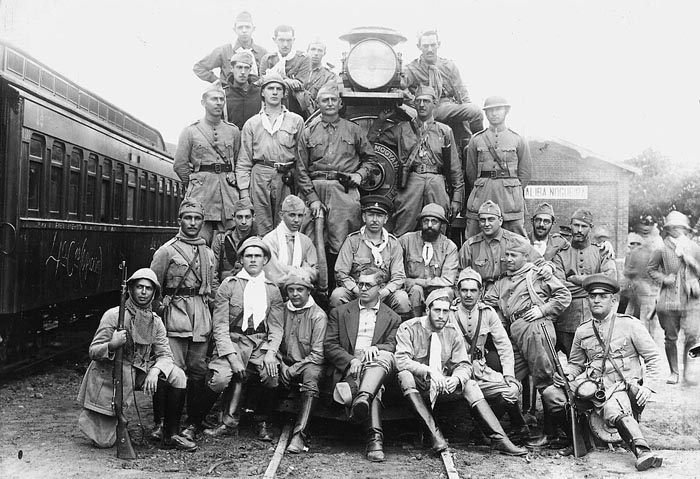
Volunteers at Itapira
Src
Books
Javier Garcia de Gabiola, The Paulista war vol.1 and 2, Latin america@war series vol.18 and 24. Helion & Co. 2020-2021Links
facebook.com/museuferroviariopaulistavfco.brazilia.jor.br
netleland.net/hsampa
docplayer.com.br
On armoured trains, google book
darozhistoriamilitar On fantasma-da-morte
orgulhodeserpaulista - On fantasma-da-morte
wiki revolution BR
j1diario.com
almanaquedosconflitos.wordpress.com
On Helion.com
mmdc.org.br/trem-blindado/
museuferroviariopaulista/
trem-blindado
/blindados-eb-parte1
pinterest.com/luigistaffa/blindados-da-revolucion
Videos
not yet.- Baldwin Railroad battery 1861
- No 6 Garrison Arm. Train 1894
- Ladysmith Train 1899
- Crewe Works 1915 coastal train
- French mobile artillery battery (1914)
- Royal Navy armoured Train 1914
- Regia Marina Arm. Trains 1915-18
- Ajmer arm. trains 1916
- Hungarian MAVAG train
- German Panzerzug Ost (1916)
- Bolshevik Armored Tram 1917
- Finnish Arm. Train (1918)
- Zaamurets (Orlík, BP-4, Lenin)
- Khunkhuz
- General Annenkov
- Yenisei
- Amur
- Terek
- Don
- Dywizja Syberyjska trains 1918
- Kozak
- Piłsudczyk
- PP3
- Gromobój
- Pionier
- Śmiały
- Lis-Kula
- Hallerczyk
- Stefan Batory
- Generał Iwaszkiewicz
- Chrobry
- Wilk
- Danuta
- Poznańczyk
- Kaniów
- Zawisza Czarny
- Zagończyk
- Paderewski
- Mściciel
- Reduta Ordona
- Huragan
- Podhalanin
- Bartosz Głowacki
- Pierwszy Marszałek
- Groźny
- Śmierć
- Śmigły
- Stefan Czarniecki
- Generał Sosnkowski
- Putilov armoured trains
- Izhorskiy Armored Train
- Czechoslovak Legion Trains
- Estonian Trains
- Lithuanian Trains
- Zhang Zongchang Train
- Danuta
- Poznańczyk
- Generał Sosnkowski
- Paderewski
- Śmierć
- Pierwszy Marszałek
- Piłsudczyk
- Śmiały
- Groźny
- Bartosz Głowacki
- Smok Kaszubski
- Drezyna R
- Drezyna TK/TKS
- UK dywizjon Trains
- SOK Draisines 1945
- Arm. draisine Crochat
- Austro-Daimler Draisine
- Armoured draisine Tatra T18
- MBV-2 Rail cruiser
- D-2 Draisine (MBV-31)
- D-37 Draisines
- Krasnaja Zvezda (KZ-1)
- D-3 Draisines
- BTD heavy Draisines (5)
- CB-1 Draisines
- DT-45 Draisines
- BD-41 Draisines (12)
- BA-I-Zhd Railcar
- BA-6ZhD Railcar
- BA-20ZhD Railcar
- BA-10Zhd Railcar
- VS-60 Train/Wagon
- BP-35L/H Train
- NKPS-42/Wagon Train (40)
- PL-35 Arty Wagon
- PL-37 Arty Wagon
- PT-35 Arty Wagon
- KV-1 Arty Wagon
- Crimean 76mm univ. Wagon
- "Tank" Wagon
- BP-42 Train/PL-42 Wagon (10)
- BP-43 Train/Wagon (54)
- 7.62mm Maxim SPU-BP Flak wagon (28)
- 37mm PVO-4 FLAK Wagon (120)
- OB-3 Light Wagon
- 27th Div armoured Trains
- 29th Div armoured Trains
- 48th Arm. Div armoured Trains
- "Stalinets" armoured Train
- "Mir Jafar Bagirov" armoured Train
- "Kozma Minin" armoured Train
- "Dzerzhinets" armoured Train
- "Za Rodinu!" armoured Train
- "Kolomensky Rabochy" armoured Train
- Zenitnyy (AA) armoured Trains
- Goering's Asien
- BP42 armoured train (full)
- BP44 armoured train (full)
- Panzerjägerwagen BP44
- BR 52, Steyr Schwerer Schienen Panzer
- Schwerer gustav Train
- P204(f) rail tank
- Schienenkampfwagen SK 1
- Schwerer Spähzug (s.Sp.) Artilleriewagen
- LeichteSchienenkampfwagen 43
- Zeppelin Panzer Draisine
- Panzertriebwagen N17
- Panzertriebwagen N16
- Panzer Draisine Funkwagen
- Panzerdraisine/Pz.III turm
- Panzerdraisine/Pz.IV turm
- Panzer Draisine Le.Sp.
- Panzer Draisine Flakvierling
- S.Panzer Draisine Kugelblitz
- L2670 leichtes panzertriebwagen
- AB Ferroviana
- Littorina OM 36
- LiBli 42
- Type K2 Steam Locomotive No.134
- Type C56 Steam Locomotive No.31
- Type 90 240 mm Railway Cannon (Futtsu Cannon)
- Type 91 Broad-gauge Railroad Tractor (So-Mo)
- Type 94 Armoured Train
- Type 95 Armoured Railroad Car (So-Ki)
- Type 98 Railroad Tractor
- Type 100 Railroad Tractor
- Type 2598 Railroad Car
- Rinji Soko Ressha 1933
- 1940 coastal defence Trains
- Royal Armoured Corps Trains
- Romney, Hythe and Dymchurch Train
- Malaya Arm. train 1942
- 101-104. sz. páncélvonat
- Finnish Winter War Train
- Croatian Armored Train
- Can. Aleutian No.1 Armoured Train
- Slovak resistance armoured train
- Iraqi armoured train (1941)
- Polish 1945-55 trains
- Arm. train La Rafale 1948
- Tren Blindado 1958
- Panser Rel V16 (1955)
- White Train 1957-87
- RT-23 Molodets ballistic wagon
- Trans-Siberian Arm. Train 1970
- North Korean Arm. Train
- Krajina express 1990
- Volga (2022)
- Baikal (2022)
19th Cent. Trains
WW1 Armored Trains
 Poland
Poland
Interwar Armored Trains
WW2 Armored Trains
 France
France
 Austria
Austria
 Czechoslovakia
Czechoslovakia
 USSR
USSR
 Nazi Germany
Nazi Germany
 Italy
Italy
 IJA
IJA
 UK
UK
 Others
Others
☢ Cold war Armored Trains
References
blog.railwaymuseum.org.ukarmedconflicts.com Russian Trains
warhistoryonline.com
feldgrau.com ww2 german trains
cuttersguide.com
wikipedia.org/wiki/Armoured_trains_of_Poland
derela.pl/drais
derela.pl/tatra.htm